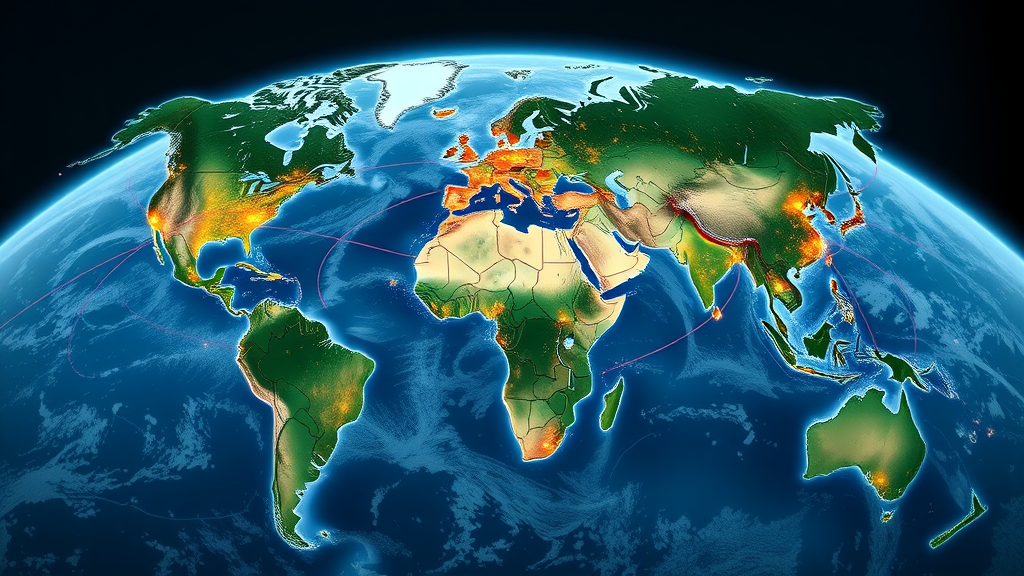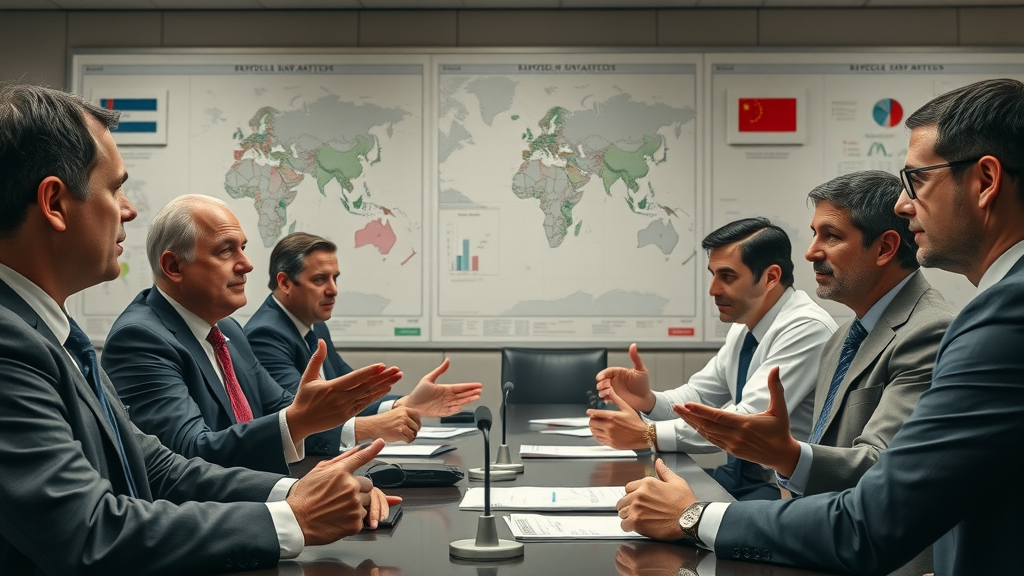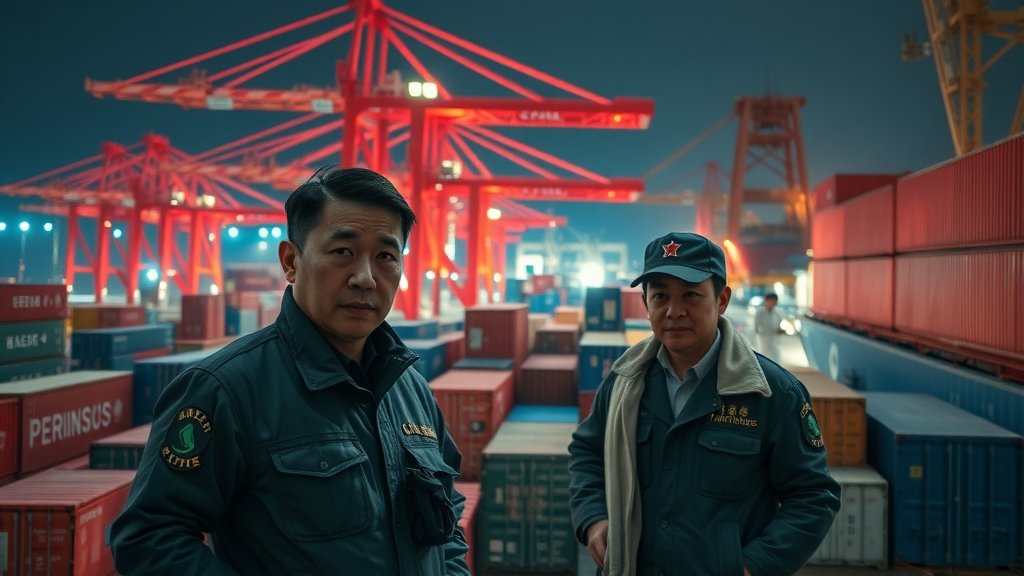Imagine this: over 75% of the world's raw materials flow is now affected by mineral export restrictions implemented by more than 60 countries in the last decade. In an era where access to rare earths and critical minerals dictates geopolitical power, understanding mineral export restrictions is essential for any trader or business navigating the complexities of global supply chains. If you think these trade controls are niche, think again—mineral export restrictions are upending industries, shifting alliances, and rewriting the rules of global commerce.
Mineral Export Restrictions: The Surprising Reality Shaping Global Trade
Mineral export restrictions are no longer subtle background noise in international trade—they've become significant factors redefining how nations and businesses access critical raw materials. According to the World Trade Organization , more than 60 countries have imposed new rules on mineral exports in the past decade. As a result, these restrictions now shape the pricing, supply, and ultimately the availability of rare earths and critical raw materials needed for every modern supply chain, from electronics to renewable energy production.
The geopolitics behind export controls are complex. Countries rich in critical minerals such as China, Russia, and the Democratic Republic of Congo increasingly use export bans and quotas to assert leverage over competing economies. The consequences? Supply chains are disrupted, prices spike overnight, and companies across the globe scramble to secure alternative sources or develop new processing technologies. Traders who fail to track these swift changes can find themselves at a sudden disadvantage in global markets.

- According to the World Trade Organization, over 60 countries implemented new mineral export restrictions in the past decade, impacting over 75% of global raw materials flows.
- Mineral export restrictions now influence the price and supply of critical rare earths and critical raw materials, affecting countless supply chains worldwide.
“Mineral export restrictions are no longer outliers—they’re the new normal. Understanding them is crucial for every trader navigating global markets.”
Why Mineral Export Restrictions Matter More Than Ever
Today, mineral export restrictions matter not just to commodity traders, but to manufacturers, technologists, and even consumers. With the world racing toward energy transition, demand for rare earth elements , lithium, cobalt, and other critical minerals has never been higher. Any government-imposed export ban or quota quickly causes price surges, supply chain bottlenecks, and fierce competition among nations and corporations alike.
These restrictions aren't limited to far-off lands. Recent US policies and European strategic mineral lists closely mirror protectionist moves abroad, reflecting a broader shift towards economic security and resource nationalism worldwide. The implications extend far beyond spreadsheets and export paperwork; they directly impact your ability to plan, price, and deliver goods reliably in a volatile market.

Understanding the Impact of Mineral Export Restrictions on Supply Chains
Mineral export restrictions have moved to the center stage of global supply chain management. When a producing country implements an export ban —as Indonesia did with nickel or China with certain rare earths—the ripple effect is immediate. Manufacturers worldwide, from battery makers to defense contractors, suddenly face shortages, increased costs, and production delays. For instance, securing raw material for electric vehicles or renewable energy systems can become a herculean task.
Traders must closely monitor the latest export controls and understand the legal, logistical, and geopolitical dimensions at play. The fallout from these controls is not only financial; reputations, contracts, and long-term business viability are also on the line. It is not uncommon for entire supply chains to reorganize, seeking out alternative suppliers, investing in recycling, or lobbying for exemptions—all in response to a single government policy shift.
How Export Controls Shape the Flow of Critical Minerals and Raw Materials
Export controls significantly alter global trade routes and determine which countries emerge as key players in critical raw materials. Take the example of rare earth export controls: China, which supplies about 60% of global rare earth elements , continually adapts its policies to regulate the market and protect its own technological industries.
- Insights on rare earth, critical minerals, and export ban policies.
- Real-world examples of raw materials export restrictions and their consequences.
The effectiveness of these measures hinges on a network of enforcement mechanisms—licensing requirements, customs inspections, and diplomatic agreements—that can change quickly. For traders, understanding the nuances of each country’s approach is crucial. For instance, nations may limit exports to protect local manufacturers or in response to political disagreements, creating a dynamic and often unpredictable business environment.
Rare Earths, Critical Minerals, and Export Controls: How They Intersect
The conversations around rare earths and critical minerals highlight the growing role of export controls in national security and economic strategy. Rare earth elements like neodymium, dysprosium, and others are essential for high-tech products ranging from smartphones to advanced military applications. However, export restrictions aimed at protecting these resources can strain alliances, raise trade tensions, and trigger retaliation from affected countries.
These resources are finite, often geographically concentrated, and subject to fierce competition. As a result, policies targeting the raw materials trade can have outsized influence, reshaping global supply chains and determining which nations lead in critical technologies. For traders and procurement officers, a nuanced understanding of these intersections is vital for long-term planning.
Comparing Export Restrictions: Rare Earths vs. Other Critical Raw Materials
Not all export controls are created equal. Some countries apply restrictions only to rare earths , while others target a broader array of critical raw materials such as cobalt, lithium, or graphite. The following table provides an overview of countries, the minerals they restrict, and the resulting impact on supply chains.
| Country | Minerals Affected | Year Enacted | Supply Chain Impact |
|---|---|---|---|
| China | Rare earths, gallium, germanium, graphite | 2010, 2023 | Major bottlenecks for electronics, EV, and defense industries worldwide. |
| Indonesia | Nickel | 2014, 2020 | Forced battery and stainless-steel manufacturers to seek alternative suppliers. |
| Russia | Aluminum, palladium | 2022 | Disrupted European and US metal markets, caused price surges. |
| United States | Lithium, certain rare earths | 2022, 2023 | Stricter export controls on technology transfer, impacting foreign buyers. |

Case Study: Critical Raw Materials and Export Control Fallout
When China imposed limits on rare earth exports in 2010, the entire global technology sector felt the shockwaves. Japanese automakers, for example, were forced to pause production, while downstream manufacturers scrambled to source materials from smaller producers at higher costs. The challenge was not limited to price—uncertainty bred delays and exposed vulnerabilities in global supply chains .
“Access to raw material defines winners and losers in today’s geopolitical chess game.” — Industry Analyst
More recently, the export ban on gallium and germanium by China in 2023 rattled chipmakers and defense contractors, further highlighting how critical raw materials can be weaponized in international negotiations. For traders, this underscores a fundamental truth: those who can anticipate and adapt to export restrictions are the most likely to thrive in the next chapter of global trade.
Export Bans and Sudden Restrictions: Recent Developments in Global Policy
If you think export bans are steady and predictable, think again. Recent years have seen a surge in abrupt policy changes as governments scramble to secure local industries and respond to diplomatic or economic provocations. These sudden shifts often leave supply chain professionals and bulk material traders little time to adapt, resulting in missed contracts and destabilized pricing structures.

Who Imposes Export Controls and Why?
National governments are the chief architects of export controls . Motives may include safeguarding economic security, protecting high-tech industries, ensuring military advantage, or retaliating against perceived foreign threats. China, the United States, Russia, Indonesia, and the European Union all play outsized roles, using bans, quotas, and burdensome licensing requirements to influence the flow of critical minerals and raw materials worldwide.
- Trends in mineral export ban implementation.
- Major players impacting supply chains with export restrictions.
While some restrictions are temporary—designed to manage short-term shortages—others become entrenched policy. Regardless of duration, the unpredictability demands that companies keep a close eye on government statements and international negotiations at all times.
Supply Chain Shockwaves: High-Profile Export Ban Examples
Consider the disruption caused by China’s 2023 export ban on gallium and germanium, or Indonesia’s restrictions on nickel. Both moves sent global buyers scrambling, with downstream industries urgently pursuing alternative suppliers or lobbying for diplomatic solutions. Such high-profile export bans teach a vital lesson: agility, risk assessment, and real-time market intelligence are essential for minimizing fallout.
The simplicity and speed with which export restrictions can be enacted maintains a state of perpetual uncertainty—one which can rapidly reshape commodity prices and influence long-term investment decisions. Whether you are a bulk raw material trader or a logistics specialist, your ability to read and react to these changes could make or break your profits.
Navigating the Practical Challenges of Mineral Export Restrictions
For businesses and traders, the reality of mineral export restrictions is less about policy and more about practical consequences. Supply interruptions, regulatory uncertainty, and reputation risk require robust, forward-thinking strategies. Adopting a proactive stance—anticipating restrictions, developing contingency plans, and educating clients—is the hallmark of a trader destined to outlast the turbulence.
Risk Management Strategies for Traders Facing Export Controls
Successful trading in the current climate goes hand-in-hand with proactive risk management . Monitor global political developments and regional tensions that might lead to new export controls . Establish direct relationships with multiple suppliers in diverse locations to spread risk. Embrace digital tools for monitoring real-time changes in trade regulations and licensing requirements.

Stabilizing Supply Chains Amid Export Restrictions
In a world of fluctuating policy, stabilizing your supply chain involves more than just finding alternative suppliers. Engage in continuous risk analysis—simulate scenarios, track regulatory announcements daily, and work closely with legal teams to ensure compliance. Explore investments in mineral recycling, refining capacity, and alternative technologies that can reduce dependence on single-source countries.
- Diversifying suppliers in the face of rare earth export restrictions
- Monitoring export controls in real time
- Understanding raw materials legal environments globally
- Investing in critical minerals recycling and alternatives
Being prepared pays dividends. The most resilient supply chains are those that can flex and adapt under pressure—a core skill in the age of mineral export controls.
Breaking the Cycle: Policy Recommendations for Mineral Export Restrictions
Policy solutions have become central to ensuring global resource access while avoiding destructive cycles of retaliatory export bans and shifting alliances. Governments and international bodies can foster resilience through greater transparency, clearer rules, and collaboration rather than unilateral embargoes.
Encouraging Transparent Export Control Rules
The first step is to promote consistent, transparent rules across jurisdictions. When businesses know what to expect, they plan better and invest with confidence. International organizations and trade groups can play a brokerage role, establishing best practices and dispute mechanisms to minimize the negative impacts of export restrictions on global supply chains.

Promoting International Cooperation on Critical Minerals
The world needs a coordinated response to mineral export bans and controls. By sharing intelligence, standardizing reporting, and forging long-term supply partnerships, countries can reduce the risk of disruptive restrictions and ensure a steady flow of critical raw materials . International frameworks that balance economic security and fair competition will be key to building resilient, equitable trade relationships.
“Without cooperation on mineral export restrictions, the global supply chain remains at risk.” — Trade Policy Expert
Did China just ban precious mineral exports to the US?
Understanding the Latest Chinese Mineral Export Ban
In 2023, the Chinese government announced new export bans on both gallium and germanium , minerals vital for semiconductor and defense industries, citing national security and economic retaliation. While not all precious minerals have been banned outright, these actions effectively targeted American and allied manufacturers, demonstrating China’s willingness to weaponize its dominance in the rare earth and raw materials space.

Is China still restricting rare earth minerals?
Rare Earth Export Controls in 2024
Yes, China still restricts rare earth mineral exports as of 2024. Over the past decade, the Ministry of Commerce issued multiple controls, shifting between quotas, licensing requirements, and even full bans on select rare earth elements . While some policies have relaxed in recent years, the threat—and impact—of renewed export restrictions remains significant for global supply chains reliant on Chinese sources.
The ongoing restrictions are poised to intensify as China continues investing in domestic rare earth processing and downstream industries, seeking to retain as much economic and technological value within its borders as possible.
What are US export restrictions?
Overview of US Mineral Export Controls
The United States maintains a variety of export controls on minerals and technologies deemed vital for national security . The Department of Commerce and Department of Defense routinely update the Commerce Control List and related regulations, controlling exports of certain raw materials and minerals, particularly those with defense or dual-use applications.
Measures have tightened in recent years in response to global competition and economic security concerns, further limiting exports to countries like China and Russia. Importantly, these US restrictions are not only about protecting domestic capacity—they are also designed to limit technological transfer to strategic competitors.
What critical minerals are China export restrictions?
Key Critical Minerals Under Chinese Export Control
China’s latest mineral export restrictions focus on minerals crucial to high-tech, renewable energy, and defense industries. These include:
- Rare earth elements (neodymium, dysprosium, terbium, etc.)
- Gallium and germanium (vital for semiconductors and fiber optics)
- Graphite (crucial for batteries and lubricants)
- Magnesium and tungsten (used in alloys and electronics)
As china dominates the mining and processing of many of these minerals, any new controls can destabilize global markets, affecting all players along the supply chain and driving innovation in material sourcing and recycling.
How to Prepare for New Trends in Mineral Export Restrictions
Forecasting Policy Shifts in Raw Material and Critical Minerals Trade
The future of mineral export restrictions will be marked by unpredictability. Nations will likely continue weaponizing raw materials amid geopolitical tensions. Companies must stay attuned to early warning signs: government policy debates, international summits, and supply chain disruption reports.
Investing in data analytics, hiring geopolitical analysts, and building relationships with regional industry insiders can provide crucial foresight for adapting ahead of new regulations or export bans .
Future-Proofing Your Business Against Export Controls
Future-proofing requires both strategic thinking and operational resilience. Invest in globally diversified supply and form partnerships beyond politically volatile regions. Embrace circular economy principles—recycling and reusing critical minerals —and support industry initiatives pushing for transparent, stable trade frameworks.
- Develop an early warning system for mineral export ban news
- Build alternative supply chain relationships
- Invest in recycled critical minerals

Frequently Asked Questions on Mineral Export Restrictions
-
What are the main drivers behind new mineral export restrictions?
The primary drivers include national security, economic security, protecting local industries, and geopolitical tensions. Countries often use export controls to leverage their dominance in certain minerals, safeguard domestic supply, or respond to perceived foreign policy challenges. -
How quickly do mineral export controls affect supply chains?
Effects can be immediate. Once announced, export restrictions may spark panic buying, price surges, and urgent supply chain re-routing, especially for industries with little inventory or few alternative sources. -
Can companies challenge mineral export bans legally?
In some cases, companies can seek recourse in international courts or via trade dispute mechanisms (e.g., through the World Trade Organization), though these processes can be lengthy, costly, and rarely offer short-term relief. -
What’s the outlook for critical minerals export controls in 2024?
Trends suggest continued unpredictability and intensification, particularly around rare earths, gallium, lithium, and graphite. Expect further coordination among producing nations and widening rifts between exporters and importers.
Key Points Every Trader Should Remember About Mineral Export Restrictions
- Mineral export restrictions are driving unprecedented turbulence across critical minerals supply chains.
- Export controls, bans, and raw material quotas can be implemented quickly and often with little warning.
- Policy awareness and agile supply chain management are crucial for long-term success.
Share Your Perspective on Mineral Export Restrictions and Influence the Future of Trade
Have insights to share on global trade? Let's talk—call us at 203-271-7991 to explore contributing an article.
What You’ll Learn
- Why mineral export restrictions are now central to global supply chain stability
- How different countries enforce export bans and the consequences for traders
- Risk management strategies for surviving policy volatility
- Steps to future-proof against evolving export controls
Conclusion
Stay informed, diversify supply, and invest in adaptive strategies—these are your strongest defenses as mineral export restrictions reshape the global trade landscape.
The landscape of mineral export restrictions is rapidly evolving, with significant implications for global trade and supply chains. The OECD’s 2025 report highlights a fivefold increase in such restrictions since 2009, noting that in 2023 alone, over 500 new raw mineral products were subjected to export controls. ( oecd.org ) This surge is largely driven by the green and digital transitions, as well as heightened concerns over economic security.
China’s strategic use of export controls has been particularly impactful. In April 2025, China imposed licensing requirements on seven rare earth elements, including samarium, gadolinium, and dysprosium, which are essential for technologies ranging from electric vehicles to defense systems. ( discoveryalert.com.au ) These measures have disrupted global supply chains, leading to increased prices and prompting industries to seek alternative sources.
The United States has also been affected by these restrictions. A U.S. Geological Survey study estimated a potential $3.4 billion decrease in U.S. GDP if China were to implement a total ban on exports of gallium and germanium, minerals critical for semiconductor manufacturing. ( usgs.gov ) This underscores the economic vulnerability associated with reliance on foreign sources for critical minerals.
In response to these challenges, there is a growing call for international cooperation. Dr. Patrick Schroeder advocates for the creation of an International Materials Agency to centralize market data, coordinate policies, and assist developing nations in managing resources sustainably. ( ft.com ) Such an agency could help balance sustainability, security, and equity in the global trade of critical minerals.
For traders and businesses, staying informed about these developments is crucial. Understanding the geopolitical dynamics and potential policy shifts can aid in developing strategies to mitigate risks associated with mineral export restrictions.
 Add Row
Add Row  Add
Add 




 Add Row
Add Row  Add
Add 

Write A Comment